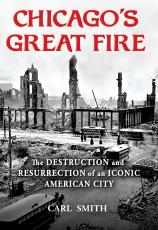Chicago's Great Fire: The Destruction and Resurrection of an Iconic American City
Review
Chicago's Great Fire: The Destruction and Resurrection of an Iconic American City
Every work of history has to strike a balance between the history of events and the history of ideas. The former is easier to write. It’s the history that’s written on the subway walls and tenement halls, preserved in handwritten letters and evening newspapers. It’s the history that happens at the foundational level. A local militia fires on a column of red-coated soldiers. A reconditioned iron-plated frigate steams into Hampton Roads to meet the only vessel in the world that can counter it. A presidential motorcade makes a slow left turn into Dealey Plaza.
The history of events can and does make for entertaining reading, especially when there is a dispute about what the events in question actually were. CHICAGO’S GREAT FIRE is on top of this, localizing the start of the fire in the O’Leary barn, but absolving Mrs. O’Leary and her cow of any responsibility for setting it. (Author Carl Smith is quite indignant about how Mrs. O’Leary was treated by her contemporaries, who cruelly caricatured her Irish roots.) The first half of the book is a comprehensive tick-tock about the spread of the fire, and how it moved across rivers and barriers and defeated the best efforts of Chicago’s noble fire brigade to contain it.
"CHICAGO’S GREAT FIRE is an exemplary historical retelling of an event that still looms large in the American imagination, and an exploration of how the response to it was shaped by the ideas and ideals of the time."
But the history of ideas is often more fascinating, and it is here where Smith finds his best expression. The first of these isn’t fleshed out, or even named in the narrative, but it is something that we can call geographical predestination. The idea here is that Chicago, after the devastating fire, was rebuilt because the location was so well-suited for a large city that rebuilding was inevitable. It’s an interesting concept, and there are plenty of good examples about how this works. There was no question that San Francisco was going to be rebuilt after its earthquake; the location was just too good. There was no real thought about abandoning New Orleans after either the 1927 floods or Katrina for the same reason. But Galveston was largely abandoned after its catastrophic hurricane, existing now as a quaint tourist town in the shadow of burly Houston. And places like Dallas, Indianapolis and Phoenix exist, although there’s no overwhelming geographic rationale for them to be where they are.
The second idea is tied into how the rebuilding was accomplished. The biggest surprise for many contemporary readers is just how uninvolved the federal government was in dealing with the crisis. There was a period when the U.S. Army stepped in to provide security in the Burnt District; this was immediately recognized as a bad idea and did not last long. There was a tussle in Congress to try to exempt wood imports destined for the rebuilding of Chicago from the protective tariff, which was opposed by the doughty St. Louis congressional delegation, just out of spite. The idea of large-scale federal relief for Chicago never seemed to have been considered --- but given the outpouring of aid that the city received from all over the country, and indeed throughout the world, that may not have amounted to much anyway.
The question of how that relief was provided is easily the most baffling for modern-day readers. The fire started in a poor neighborhood, but it spread north to afflict upscale residences as well. The prevailing sentiment from the various aid committees was that the wealthy people who had lost a great deal in the fire were more deserving than the poor, who had lost everything they had. Smith reports this without editorializing, but it’s clearly not an attitude that would garner much support today. (He also reports on a kerfuffle involving the complaints lodged by Chicago matrons against the kind people of Cincinnati, who had sponsored a soup kitchen; the matrons felt that the soup was not nutritious.)
CHICAGO’S GREAT FIRE is an exemplary historical retelling of an event that still looms large in the American imagination, and an exploration of how the response to it was shaped by the ideas and ideals of the time. It manages the difficult balance between these two modes expertly, with an eye towards both the interesting anecdotal narrative and the greater historical significance.
Reviewed by Curtis Edmonds on October 30, 2020
Chicago's Great Fire: The Destruction and Resurrection of an Iconic American City
- Publication Date: September 14, 2021
- Genres: History, Nonfiction
- Paperback: 400 pages
- Publisher: Grove Press
- ISBN-10: 0802159125
- ISBN-13: 9780802159120



